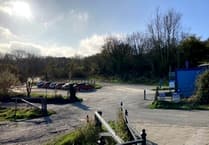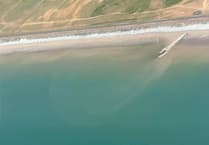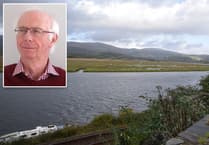“The algae bloom is the worst I’ve ever seen,” Cardigan resident Julie Boltwood told the Cambrian News.
“I swim for my mental health and wellbeing so this summer I’m really struggling.
“I managed to get a couple of swims in late May but when the bloom started to get so thick the water was brown, I couldn’t go in – it feels greasy on your skin.
“On top of that the smell is horrible. On bad days it’s been overwhelming in my flat and I know it’s been the same for a friend of mine.”
An incursion of thick, foul-smelling algae has at times swamped the Cardigan Bay shoreline in the last few weeks.
It has caused alarm in coastal communities, particularly because of its repellent brown colour and fishy, sewage-like odour.
It has been said to resemble the froth at the head of a pint of Guinness, faecal scum or watered-down brownish tapioca.
An Aberdyfi chartered sea-angling skipper, Charlie Bartlett, said he has not seen an algal bloom like it in 54 years of operating fishing boats.
Lifelong surfer and Tywyn resident Robert Turner and New Quay-based marine biologist Dr Sarah Perry, of the Cardigan Bay Marine Wildlife Centre, said it was also the worst they had ever seen.
The Cambrian News has been provided with images of dead fish, birds and marine wildlife and has heard from residents who say they have become ill after swimming in the sea.
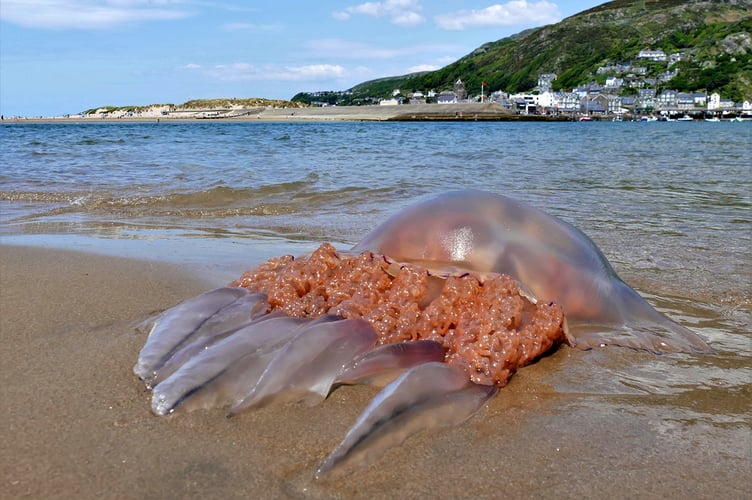
Mr Bartlett said there were very few fish over the reefs, and anglers in Tywyn reported seeing effluent and toilet paper.
In some coastal communities like Aberystwyth, signs have been erected on the beach warning against swimming. Although it is unclear who placed them there, one sign from 12 June says: “Swimming is not advised today. Sea water on the beach may be of a lower quality than usual.”
In Tywyn, the bloom has prompted hysteria about potential sewage discharge accelerating the algae growth — particularly as tens of thousands of gallons of extra effluent from the Dolgellau treatment works – currently closed for ‘essential maintenance’ – is being transported in lorries to a plant in Tywyn, placing an extra strain on the system.
Business owners are hoping the bloom subsides soon due to the negative consequences it could have for an area dependent on tourism in the summer months.
Links have also been made to the sudden explosion of jellyfish numbers which might be feeding on the algal bloom.
Marine scientists at the Wildlife Trust have this week warned that more jellyfish – including more venomous species – could follow if the sea heatwave continues, while species of poisonous algae could develop. Recent warnings have been issued about toxic algae in Lake Windermere and in other locations across the UK.
In short, there are widespread concerns the algal bloom could become a seasonal feature – and could get much worse.
Water quality campaigners are acutely aware of the consequences of algal bloom, which can deoxygenate the water and lead to the death of aquatic life.
They’re also familiar with the causes, as wastewater and agricultural run-off like slurry are major producers of phosphates and nitrates – well known to contribute to algae growth.
In the US, concerning phenomena such as mass fish suffocation due to low oxygen in the water off the coast of Texas as well as dolphins and other marine mammals dying due to toxic algae will concern European audiences greatly.
Experts agree the onset of the climate crisis, which has prompted a scorching early summer, is the primary driver of the almost unprecedented bloom.
The North Atlantic, including around the UK, has been experiencing record-breaking temperatures.
The global sea surface heat for both April and May were the highest on record for those calendar months in a series stretching back to 1850.
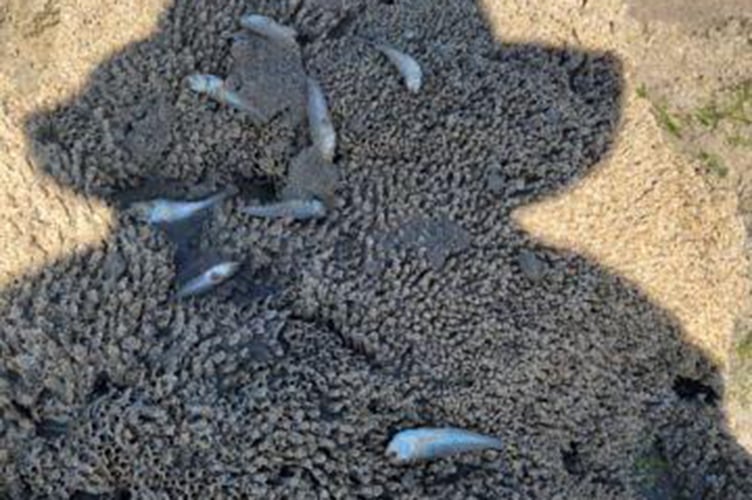
Seawater temperatures in Cardigan Bay are likely to have risen to nearly two or even three degrees above normal for this time of year, roughly in line with the rest of the North Atlantic Ocean.
Met Office chief scientist Professor Stephen Belcher said: “You can see that the eastern Atlantic, from Iceland down to the tropics, is much warmer than average.
“But areas around parts of north-western Europe, including parts of the UK, have among some of the highest sea-surface temperatures relative to average.
“May 2023 was nominally the warmest May in the sea-surface temperature around the near-coastal waters of the UK since the late nineteenth century. The value is about 1.60°C above the average for May over the period from 196 to 1990.”
Environmental regulator Natural Resources Wales has been regularly testing the waters in Cardigan Bay and has sought to reassure swimmers that the algae is non-toxic and unrelated to pollution.
It said: “A number of water samples have confirmed the presence of phaeocystis algal blooms along the coast at locations between Aberdyfi and Harlech, including Tywyn. This is part of a more extensive bloom in Cardigan Bay that has been recorded along the Welsh coastline.
“These non-toxic blooms form a brown, frothy scum on the water and when breaking down can smell like sewage. Algal breakdown can lead to low oxygen and fish distress in warm shallow waters.”
But natural geography professor Callum Firth, formerly of Brighton and Canterbury universities, who specialises in coastal systems and climate change, agreed with some of those concerned in Tywyn.
He said that wastewater released from sewage treatment works could contain high concentrations of phosphates and nitrates and could, in theory, intensify an algal bloom.
As the bloom has begun to subside in south Ceredigion and around Cardigan, it is still persisting along beaches between Harlech and Aberystwyth – at the centre of which is Tywyn sewage treatment works.
Professor Firth said: “Algal blooms form when you have warm water, sunny weather and high levels of nutrients.
“The temperatures of coastal waters off UK and Ireland are exceptionally warm this year.
“In Cardigan Bay we’re probably looking at three degrees warmer sea surface temperatures than average this year.
“I’ve got solar panels on my roof and normally I’d be expecting to generate about 600 kilowatts in May – but this May I’ve generated 900kw.
“So, last month has probably been about 50 per cent sunnier than usual, ideal for the algal blooms to occur.
“They would have been promoted further if there were high levels of phosphates and nitrates in the sea.
“This year has been far more noticeable than usual.
“Sewage would add to that set of nitrates but even when it is treated it doesn’t necessarily take the phosphates and nitrates out – only the solids.
“The water coming out of wastewater treatment works is very high in nutrients.
“In land waters there are limits to what can be discharged but I’m not sure what those limits are in coastal waters.
“If the quantity of the water being deposited is higher, then more water containing phosphates and nitrates is being pumped out.”
The nation’s primary water supplier Dŵr Cymru, which operates the site in Tywyn, and NRW say there have been no unpermitted discharges and that all extra sewage is being treated and then compliantly released.
Dŵr Cymru says the Combined Sewage Overflow (CSO) drain, for use only when the system is under extreme pressure, was last activated in December. It is also operating well under capacity due to the dry weather, the firm added.
But NRW appears only to have tested the bathing water on 23 May and 5 June, when residents say the brown slick – which smelled like and resembled sewage – appeared on 28 May.
Some regional experts focused solely on the extreme temperatures the area has been experiencing.
“
What we have been experiencing in Cardigan Bay is likely a consequence of climate change; perhaps this is the sort of scenario we should expect in future years.
Dr Sarah Perry, Cardigan Bay Marine Wildlife Centre
Professor Paul Shaw, chair of the Department for Life Sciences at Aberystwyth University, said: “Blooms of marine algae occur every year around our coasts in the British Isles, with the spring bloom typically occurring in April and May as seawater temperatures rise and sunlight levels increase.
“This year there have been local weather conditions conducive to a later, larger and more noticeable bloom.
“The calm sea conditions also will have kept the algae in surface waters and not dispersed the bloom, resulting in lots washing ashore.
“In terms of the reports of fish dying, it is important to note that as algae bloom and die they decompose, removing oxygen from the water.
“This stresses fish, and they move to deeper or offshore waters to find higher levels of oxygen.
“Warmer water can also hold less oxygen, so an algal bloom that coincides with high levels of warming can further reduce oxygen levels.”
Dr Perry told the Cambrian News she is awaiting results of water surface temperature tests in Cardigan Bay – and would be intrigued to see if water quality is worse this year when compared to previous years, despite the levels being compliant.
She said: “The heatwave we are currently experiencing will without a doubt have an impact on species and habitats within the marine environment and thus will likely be a contributing factor to the amount of algae that we have seen/experienced here in Cardigan Bay (and other places around Wales) in recent weeks. It is likely that we won’t know the extent of the impacts of this on the marine environment for a while.
“As we know, the climate crisis we are all living through does and will lead to extreme weather and climate scenarios, and thus what we have been experiencing here in Cardigan Bay is likely a consequence of climate change and perhaps this is the sort of scenario we should expect to experience in future years.
“Algal blooms are common at certain times of year, particularly when the sea has had a chance to begin to warm but I can’t recall ever having seen them to such an extent and so early in the year as we have experienced this year.”
So, when will the algal bloom finally disappear? And when will coastal residents be rid of the stench it brings with it?
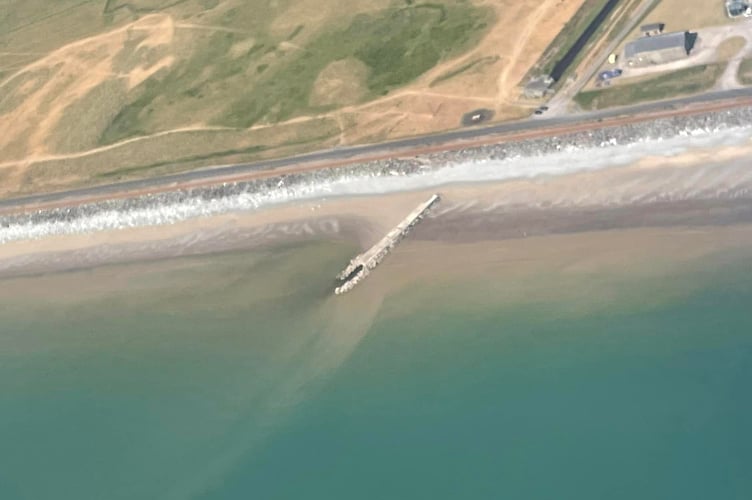
St Dogmaels resident and environmental campaigner Piers Partridge took videos of the algae at its height in May – and he also encountered a dead seagull which he feared could be related to the bloom.
“It has looked bad this year,” he said. “My feeling is something isn’t right with algae bloom.
“We need to know the contents of it. We need to test and test and test and monitor the algal bloom – and experts need to get involved – otherwise we’re going to lose the water quality that is so precious to us.
“I posted a video of the bloom at Poppit Sands on a day when it was still. There were no waves.
“So, we need testing and a noticeboard. I know of several local swimmers who have become unwell after swimming; to have been warned would have saved them a lot of discomfort and time off work.”
Villagers in Borth have been describing how many are avoiding the water and how awful the smell is, which has prevented them from opening their windows in some cases.
Borth resident and Extinction Rebellion activist Susanna Kenyon said: “I know others in Borth who are very concerned about not being able to go swimming.
“It would be good to get to the bottom of it. I think it’s a combination of factors and it’s only going to get worse.”
Fellow Borth resident Tracey Jones said, as the climate gets hotter, she fears seasonal algal blooms will become worse as they are in other countries.
She said: “I’m no expert but I’ve previously been on holiday to Mexico where they’re suffering badly with sargassum. That smells like rotten eggs as it’s releasing sulphide.
“Apparently caused by climate change – and changes in sea temperature – it suffocates wildlife and other types of seaweed.
“They cannot get on top of it. It’s only a matter of time before it comes here.”
Several readers commented about their experiences of ‘crystal clear’ waters in Pembrokeshire with no foul smells – and questioned why it is only so bad on this particular stretch of Cardigan Bay.
Others were completely unfazed and said they had been swimming freely and had endured no illnesses.
“I swim loads off Borth beach out around the reef, often further out,” one reader said.
“Yes, it was smelly, but I also remember similar 10 or so years ago... but never suffered any issues from it.”
Concerns about the algal bloom being connected to sewage have been dismissed by many as hysteria due to misinformation and a heightened concern about water quality and sewage pollution across the nation.
An Aberdyfi resident, who preferred not to be named, told the Cambrian News: “Altogether it is totally heartbreaking to see our beautiful seas and beaches becoming so spoiled and the livelihoods of our communities threatened.”
As questions remain about potential pollution, it seems Cardigan Bay communities will continue to pay the price for the hot weather in the form of algae – which could become an annual occurrence.
How has the increased algal bloom affected your enjoyment of the coastline? Get in touch today: email [email protected]




